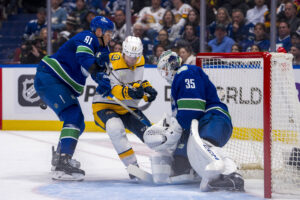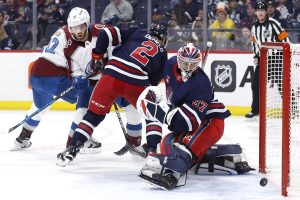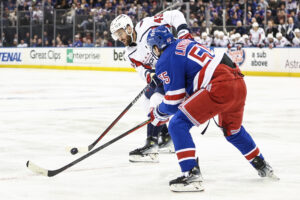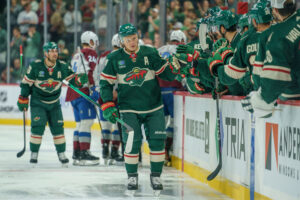Welcome to the 2018 Top Shelf Prospects series. As we go through the Summer of 2018 LWOH will be featuring a team-by-team look at the top prospects in the NHL. We will be following the order of the first round of the NHL draft (as if there were no traded draft picks) and you can find all the articles here. Since we had an extensive NHL Draft preview, we will not be reviewing the players who were drafted in the 2018 draft, as there have been no games since then, and our reports on them will not have changed.
 What we will be doing is linking you to those articles, as well as taking a look at prospects that were acquired before this year’s draft; their progress, and their chances of making the 2018-19 roster of the NHL team in question. We will also bring you one sleeper pick – a player who was either drafted in the 4th-round or later, or was an undrafted free agent signing who we pick as our dark horse to make the NHL. For those wondering, the cut-off for what is or isn’t a prospect is typically about 50 NHL games played (including playoff games) or is 25 years old. These are not hard or fast rules though, and we may make some exceptions depending on the circumstances.
What we will be doing is linking you to those articles, as well as taking a look at prospects that were acquired before this year’s draft; their progress, and their chances of making the 2018-19 roster of the NHL team in question. We will also bring you one sleeper pick – a player who was either drafted in the 4th-round or later, or was an undrafted free agent signing who we pick as our dark horse to make the NHL. For those wondering, the cut-off for what is or isn’t a prospect is typically about 50 NHL games played (including playoff games) or is 25 years old. These are not hard or fast rules though, and we may make some exceptions depending on the circumstances.
Los Angeles Kings Prospects
After missing the playoffs in 2016-17, the Los Angeles Kings made a number of changes including naming a new general manager and head coach. Rob Blake and John Stevens would lead the Kings back to the playoffs in 2017-18, as they took the top wildcard spot. The Kings got a stellar season from Anze Kopitar, a resurgent campaign from Dustin Brown, another Norris finalist season from Drew Doughty, and a Jennings winning season from Jonathan Quick (with a huge assist to the entire team’s defensive play). However, the Kings would fall in four straight to the Vegas Golden Knights in the first round of the playoffs.
The Kings would try to address their biggest glaring deficiency, goal-scoring, in the off-season. Their big move is the signing of Ilya Kovalchuk. The Kings hope that as the 35-year-old comes back from the KHL, he hasn’t lost any of his sniping ability. Los Angeles also made headlines by signing Doughty to a huge eight-year contract extension. The move keeps one of the best defencemen in the NHL in Los Angeles through the prime of his career. However, outside of the Kovalchuk move, the Kings haven’t made any other big additions, and so, any other improvements will need to come from their prospects.
2018 NHL Draft Picks: Rasmus Kupari, Akil Thomas, Bulat Shafigullin, Aidan Dudas, David Hrenak, Johan Sodergran, Jacob Ingham
Graduations: Adrian Kempe, Jack Campbell (age), Alex Iafallo, Oscar Fantenberg (age),
Top Prospect: Gabriel Vilardi
Centre — shoots Right
Born August 16th, 1999 — Kingston, Ontario
Height 6’3″ — Weight 201 lbs [191 cm/91 kg]
Drafted by the Los Angeles Kings in the 1st round, #11 overall at the 2017 NHL Draft
Vilardi was injured and missed the start of the OHL season. While he was out of the lineup, he was moved from a rebuilding Windsor team to a Kingston Frontenacs club looking to compete for an OHL title. Vilardi had a great second half putting up 22 goals and 58 points in 32 games. He also added 11 goals and 22 points in 16 playoff games. It was not enough though, as the Frontenacs fell in the conference final to the Hamilton Bulldogs.
Skating
Vilardi has decent but not great speed. He uses it to get in quickly on the forecheck and cause problems by pressuring defenders to make quick decisions. If they do not move the puck quickly, he is able to punish them with a big hit. Vilardi also has a good first step and decent acceleration. He is better described by the word quick than the word fast. This allows him to pounce on loose pucks in the offensive zone.
Vilardi has good balance and power in his stride. He protects the puck well down low on the cycle and can fight through checks and take the puck to the front of the net. His balance also helps him to win battles along the boards and in front of the net. It should continue to improve as he adds lower body strength in the coming years. Vilardi also has decent agility for a big man, helping him to avoid defenders, both with and without the puck.
Offensive Game
Vilardi has a very long reach and excellent puck handling ability. He uses these assets to extend plays and wait for teammates to get open, before hitting them with a pass. Vilardi has the vision and passing skill to be a solid playmaker, both off the rush and in the cycle game. Vilardi is constantly moving and getting involved in the play. He is extremely gritty and involved in battles along the boards and in front of the net.
The power forward prospect also has a very good wrist shot and an excellent release. His shot is powerful and deadly accurate. He also has the hands to finish plays in tight to the net, scoring on rebounds, tip-ins and one-time plays. His hockey IQ is also above average. Vilardi makes smart plays with the puck, as well as understanding how to get open without it.
Defensive Game
Vilardi has shown a willingness to be involved in the play in all three zones. He shows great effort on the backcheck and helps out the defenders down low. His positioning can be improved but he has shown a willingness to work on and improve his game during his two years in the OHL. Vilardi has a lot of potential but will need to keep working on this aspect of his game.
Outlook
Vilardi is close to NHL ready, but might not quite be there yet. Complicating matters is the fact that he cannot be sent to the AHL but instead must be sent to the OHL if he is not on the Kings roster. Unless he has a disastrous camp, the Kings should keep Vilardi up to start the year and assess him in regular season games. Before he plays his 10th NHL game, they must decide whether or not to burn a year of his rookie contract and keep him in the NHL or send him back to junior.
#2 Prospect: Kale Clague
Defence — shoots Left
Born June 5th, 1998 — Lloydminster, Alberta
Height 6’0″ — Weight 177 lbs [183 cm / 80 kg]
Drafted by the Los Angeles Kings in the 2nd round, #51 overall at the 2016 NHL Draft
Clague split last season between the Brandon Wheat Kings and Moose Jaw Warriors as he was moved at the WHL trade deadline. He was again one of the best defencemen in the league and put up 11 goals and 60 assists for 71 points 54 games. Clague also added a goal and 14 points in 14 playoff games as the Warriors fell in the second round to the eventual league champion Swift Current Broncos. He also played for Team Canada at the World Juniors. As one of their most used defenders, he put up two points in six games and won a gold medal.
Skating
Clague is an outstanding skater. He has great top-end speed and acceleration in both directions allowing him to be an effective two-way defender. Clague can join the rush or make pinches in the offensive zone and still get back quickly on defence. He pairs the speed with good agility, pivots, and balance. This allows him to cover a huge amount of ice and transition quickly and easily from defence to offence or vice versa. He could stand to improve his lower body strength to improve his balance and win more board battles, as well as be better in clearing the front of the net.
Offensive Game
Clague skates the puck up the ice well. He has good stick handling ability and can use his agility to avoid forecheckers and create space to lead the rush. He can also start the transition game with a strong first pass out of the zone and often follows that pass to continue the attack. A natural power-play quarterback, Clague can walk the line, throws strong, crisp passes, and has excellent vision.
His slap shot is decent, but not overpowering. It can be improved by adding some muscle to his frame. He already understands how to keep it low and on the net and how to get his shot through traffic. Clague also has a strong wrist shot which he uses to get the puck on net when facing pressure at the blue line.
Defensive Game
Clague’s defensive game is very good in junior, as he often plays against the other team’s top lines. He works extremely hard to battle in the corners but could use a bit more strength and balance. He has a quick stick and pokes pucks away from opponents on the rush, and intercepts passes to create transition. Clague has good positioning and defensive gap control, keeping opponents to the outside. He could work on being more physical in his own end, but that can also come with increased strength.
Outlook
Clague leaves his junior career behind him and heads up to the pros. While he will hope to win a spot in Kings training camp, it is far more likely that he starts the season with the Ontario Reign in the OHL. Clague could be a call-up if the Kings face any injury issues. He is likely a year or two away from being a full-time NHL player but could make a big impact when he arrives.
#3 Prospect: Rasmus Kupari
The Kings drafted Kupari with the 20th overall pick in this year’s NHL draft. Prior to the draft, we did an in-depth scouting report on Kupari. As no games have been played since that report; we will not repeat it. You can check out the report here.
#4 Prospect: Jaret Anderson-Dolan
Centre — shoots Left
Born September 12th, 1999 — Calgary, Alberta
Height 5’11” — Weight 188 lbs [180 cm / 85 kg]
Drafted by the Los Angeles Kings in the 2nd round, #41 overall, at the 2017 NHL Draft
Anderson-Dolan had an outstanding season with the Spokane Chiefs. He scored 40 goals and 91 points in 70 games. He also added nine points in seven playoff games, but the Chiefs fell in the first round. Anderson-Dolan then joined the Reign, putting up two points in five regular-season games but failing to record a point in three playoff games.
Skating
Anderson-Dolan is a very good skater. He has an outstanding first step and great acceleration, as well as very good top-end speed. Anderson can beat defensemen one-on-one. Once he gets a step on a defender, he can cut to the inside, drop his shoulder and drive the net. He has the strength and balance in his lower body to fight through checks as he makes the drive to the net. He is also hard to knock off the puck as he battles along the boards. Anderson-Dolan also has very good edgework and agility. He can make quick cuts and changes of direction to fool defenders and manoeuver in traffic both with and without the puck.
Offensive Game
Anderson-Dolan also uses his excellent skating to get in quickly on the forecheck, pressuring defenders into mistakes and creating turnovers. Once he does get a turnover, he uses his strength on the puck to protect it down low and extend possession. More a goal scorer than a playmaker, Anderson-Dolan still shows good vision and passing skills.
Anderson-Dolan’s dogged determination is also an asset around the net. He scores goals in tight to the goalie by using his soft hands after driving the net, or by knocking in rebounds, or a short one-timer on a quick pass. His wrist shot is also a weapon from further out as he has surprising power, and a quick release. Anderson-Dolan also has an effective one-timer. His hockey IQ allows him to find the soft spots in the defence and set himself up to receive the pass and fire a shot on goal.
Defensive Game
Anderson-Dolan has a well developed defensive game for his age. His speed and quickness help him to get to loose pucks and he does this in all three zones. It also helps him to pressure puck carriers and cut down options for attackers. He is very good at transitioning a turnover into the offence. Anderson-Dolan is a good penalty killer and can be matched against an opponent’s top line. He could still stand to work on his positioning though and on staying disciplined with his man, instead of chasing the puck.
Outlook
Anderson-Dolan will spend another season in junior. How that season unfolds is based, in large part, on if the Chiefs are ready to take the next step and become a true WHL contender. If they aren’t at that level, expect to see Dolan traded to a contender at the WHL trade deadline and gain valuable playoff experience. He also has a chance to compete for a spot with Canada at the World Juniors.
#5 Prospect: Akil Thomas
The Kings drafted Thomas with the 51st overall pick in this year’s NHL draft. Prior to the draft, we did an in-depth scouting report on Thomas. As no games have been played since that report; we will not repeat it. You can check out the report here.
#6 Prospect: Cal Petersen
Goalie — shoots Right — catches Right
Born October 19th, 1994 — Waterloo, Iowa
Height 6’1″ — Weight 182 lbs [185 cm / 83 kg]
Drafted by the Buffalo Sabres in the 5th round, #129 overall, at the 2013 NHL Draft
Signed with the Los Angeles Kings in June 2017
Petersen had a solid first professional season with the Reign. In 41 games, he put up a 2.58 goals-against average and 0.910 save percentage. He also played in four playoff games with a 2.38 goals-against average and 0.915 save percentage.
Talent and Skating Analysis
Coming in at just 6’1 tall, Petersen is a little short when we look at the trend of bigger goaltenders in the NHL. He does make himself look big in the net though, by getting out far to challenge shooters. He is a good skater, with powerful legs. This allows him to avoid being deked out when he does challenge a shooter. He also is quick side-to-side on cross-ice passes.
Petersen has quick legs. He is very tough to beat down low. He has excellent technique and gets in and out of his butterfly quickly. The goaltender protects the top of the net with a lightning quick glove hand. His rebound control is very good for a young prospect. When he does give up a rebound, he stays square to the puck and gets back into position quickly. Petersen is able to get out of his net and start the breakout with a pass to his defencemen.
Mental Makeup
Petersen was a leader in college, even being named the captain of the team at Notre Dame. He is a calm goaltender, even when things get crazy around the crease. This calm permeates out to the defence and the rest of the team. He does not give up bad goals often but when he does he quickly shakes it off and is ready for the next shot.
Outlook
Petersen will likely spend another season as the starter for the Ontario Reign in the AHL. He is a year or two away from being NHL ready. If he continues to develop, he will eventually battle Jack Campbell for the backup role in Los Angeles.
#7 Prospect: Daniel Brickley
Defense — shoots Left
Born March 30th, 1995 — Sandy, Utah
Height 6’3″ — Weight 203 lbs [191 cm / 92 kg]
Signed by the Los Angeles Kings as an undrafted free agent in March 2017.
Brickley was the top undrafted free agent coming out of the NCAA this year. As a junior with Minnesota State (Mankato), he put up 10 goals and 35 points in 40 games. After signing with the Kings, he played one NHL game and picked up his first NHL point, an assist.
Skating
Brickley is a decent, but not a great skater. His stride is a little unorthodox and he could really benefit from working closely with a top skating coach. This would help him to be a little bit faster in his straight-line skating as well as improve his acceleration. Brickley’s agility and edgework are very good. This gives him strong lateral mobility. Brickley also has a powerful lower-body which gives him good balance. This helps him to win battles along the boards and in front of the net.
Offensive Game
Brickley is an offensive force from the blue line. He has an outstanding slap shot, and a good wrist shot with a quick release. He uses both effectively and gets them on the net. Brickley is very effective as he sneaks down from the point to get off his wrist shot from the top of the circles. Brickley is even more effective on the point due to his good lateral mobility. His ability to walk the line opens up passing and shooting lanes.
Brickley also has good passing skills and vision. He has very good hockey IQ and anticipates the movements of his teammates and what they are going to do on the ice. He can make a tape-to-tape pass in very tight areas to set up a scoring chance. Brickley is also good at starting the transition game, making solid passes out of the zone. He is willing to join the rush as a trailer.
Defensive Game
Brickley’s skating helps his defensive game, as he maintains good gap control and is willing to battle in the corners and in front of the net. While he is not a huge hitter, he engages physically and is not pushed around. He funnels opponents to the outside and uses his stick to cut down passing lanes. Brickley is willing to block shots as well. He can get out of position at times and will need to work on that going forward.
Outlook
Brickley will head to Kings camp looking to make the roster. Even though he was given an NHL game last year, this is by no means a guarantee that he will make the roster. While he is close to NHL ready, he still has some areas of his game that can be improved, particularly his straight-line skating. He could spend some time in Ontario working on improving those areas. At the very least though, expect Brickley to be a call-up in case of injury. He could be a full-time NHLer in the second half of next season or in 2019-20.
#8 Prospect: Mikey Anderson
Defence — shoots Left
Born May 25th, 1999 — Roseville, Minnesota
Height 6’0″ — Weight 196 lbs [183 cm / 89 kg]
Drafted by the Los Angeles Kings in the 4th round, #103 overall at the 2017 NHL Draft
Anderson had an excellent freshman season as a part of the University of Minnesota-Duluth. He played top-4 minutes on the National Championship squad. Anderson put up five goals and 23 points in 39 games. He also played for Team USA at the World Juniors, picking up one assist in seven games and winning a bronze medal.
Skating
Anderson has good speed and acceleration in both directions. He reaches that top-end speed quickly, thanks to a strong stride and good acceleration. Anderson has very good lateral agility and edgework. He keeps opponents in front on him and is difficult to beat in one-on-one situations. He also has a strong lower-body giving him good balance and making him effective in one-on-one battles along the boards.
Offensive Game
Anderson moves the puck quickly, getting it up ice by skating it out of danger and making a quick outlet pass. He has excellent vision and transitions the puck forward quickly. He hits forwards in stride with both short passes as well as a long breakout pass. Anderson also has a good shot but must show better lateral agility to open up shooting lanes in the offensive zone.
Defensive Game
Anderson is a solid defensive player. He maintains very good gap control. He forces opponents to the outside keeping himself between the net and the puck. Anderson is not afraid to put his body on the line and block shots. His active stick is effective in poke-checking pucks away from attackers and cutting down passing lanes. When a turnover is created, Anderson can retrieve the puck and transition to offence quickly. He could improve even more if he was more physical in his own end of the rink. One of his issues is keeping the front of the net clear.
Outlook
Anderson returns to Minnesota-Duluth for his sophomore campaign looking to help the team defend their national championship. With the less intense college schedule, he will get plenty of time to go to the weight room and look at increasing his strength. This would really help his game. Anderson is also eligible to play for the US team in the World Juniors again.
#9 Prospect: Michael Amadio
Centre — shoots Right
Born May 13th 1996 — Sault Ste. Marie, Ontario
Height 6’1″ — Weight 204 lbs [185 cm / 93 kg]
Drafted by the Los Angeles Kings in the 3rd round, #90 overall, at the 2014 NHL Draft
Amadio bounced between the Reign and the Kings last season. He only put up four goals and eight points in 37 NHL games. He also had on assist in his only Stanley Cup Playoff game. Amadio was a scoring star at the AHL level with 11 goals and 35 points in 32 games and four points in four playoff games.
Skating
Amadio is a very good skater. He has strong acceleration and good top-end speed. He can beat defenders with a change of pace and once he gets by them can create separation. Amadio also has excellent edgework and agility. He can change directions on a dime and this is a weapon he can use to get by an opponent. He must get stronger though. Amadio’s lower body strength and balance mean he can sometimes suffer when battling with stronger opponents.
Offensive Game
Mainly a playmaker, Amadio has good vision and passing ability. He uses strong stickhandling skill and his speed to control the puck on the cycle, waiting for a teammate to get open. Once a teammate gets free, Amadio hits them with a pass. He can be even better in possession if he gets stronger on his skates. While Amadio has decent power on his wrist shot and a quick release, he could stand to use that shot more often. He is also a very accurate shooter.
Amadio works hard to win board battles and establish his position in front of the net. His speed helps him to get in quickly on the forecheck where he pressures defenders and forces mistakes and turnovers. He plays a very gritty game and is always moving his feet. He could stand to add some muscle though.
Defensive Game
Amadio continues to be given important defensive responsibility in the AHL. He was often used to check the other team’s top line. Amadio is strong in cutting down passing and shooting lanes and provides back pressure to support the defence. He has a high hockey IQ and anticipates plays and causes turnovers. He was good on face-offs as well.
Outlook
Expect Amadio to make the Kings out of camp. He should be an important part of their penalty kill and play on the fourth line. In time, Amadio could grow into the role of a third line centre in the NHL but it is unlikely that he becomes a top six player.
#10 Prospect: Alexander Dergachyov
Center — shoots Left
Born September 27th, 1996 — Langepas, Russia
Height 6’5″ — Weight 220 lbs [195 cm / 100 kg]
Drafted by the Los Angeles Kings in the 3rd round, #74 overall, at the 2015 NHL Draft
Dergachyov split time between SKA St.Petersburg and Spartak Moscow as he went out on loan last season. He put up seven goals and 13 points in 36 KHL games. He also played in four playoff games but did not put up a point.
Skating
Dergachyov is a good skater, especially for his size. He has above-average speed and acceleration. However, it is his strength and power that really set him apart. Dergachyov is able to take advantage of his powerful lower body to gain leverage and win board battles. He also has the ability to fight through checks and take the puck to the net. Dergachyov shows decent agility, which combined with his good stickhandling can make him a threat in one-on-one situations, whether that be off the rush, or in working the cycle game.
Offensive Game
Combining outstanding size and some skill, Dergachyov has many of the attributes that NHL teams are always searching for. He has very good hands and can get around defenders or finish in tight to the net. His goal scoring potential is limited though. While he has a powerful shot, he needs to work on his release. It takes him a little bit too long to load up and get his shot off which allows goalies to get in position to make the save.
Dergachyov has decent vision and playmaking ability. He protects the puck well in the cycle game and wins board battles, which he then is able to use to create opportunities for teammates. Dergachyov uses his size and his leverage well, in playing a gritty game, retrieving loose pucks, establishing his position in front of the net, and winning battles along the boards. He gets in quickly on the forecheck, pressuring defenders and creating turnovers in the offensive zone.
Defensive Game
Dergachyov is willing to bring his gritty game in all three zones. He backchecks hard and helps teammates contain the cycle game down low. His long stick can be used to poke check opponents and to cut down on passing lanes. He is already an accomplished penalty killer, creating turnovers and getting the puck down the ice. When he is able to create turnovers at even strength, he is able to transition quickly to the attack. Dergachyov’s two-way game, including his face-off skill, will be extremely important at the next level.
Outlook
Dergachyov’s contract with SKA ends this summer. The Kings could be interested in bringing him over to North America next season. He could be a big centre, valuable in their bottom six. However, Dergachyov is unlikely to be a big scorer.
Sleeper Prospect: Markus Phillips
Defence — shoots Left
Born March 21st, 1999 — Toronto, Ontario
Height 6’0″ — Weight 202 lbs [183 cm / 92 kg]
Drafted by the Los Angeles Kings in the 4th round, #118 overall, at the 2017 NHL Draft
Phillips had another solid season for the Owen Sound Attack. He put up 10 goals and 39 points in 68 games. He also added three points in 10 OHL playoff games.
Skating
Phillips is a very smooth skater. While his speed is very good, it is not quite elite. However, his stride gives him very good acceleration, and he is very quick to loose pucks. He also has excellent edge work and pivots. Phillips transitions quickly from offence to defence and vice-versa. His backwards skating is almost as good as his forward movement and makes him difficult to beat. Phillips has outstanding lateral agility, helping him defensively in maintaining gap control, as well as offensively in making plays at the offensive blue line.
Offensive Game
Markus Phillips can score from the point with a very good slap shot and a strong wrist shot. His slap shot is especially effective as a one-timer. With the puck on his stick, he has the poise to control the play and walks the line to open up passing and shooting lanes with his lateral agility. Phillips also has a very good wrist shot and excellent release. He can sneak down from the point to let it go, as well as using it as a trailer on the rush.
Phillips strong skating and puck handling skills allow him to lead the rush. He has good vision and can make a strong pass to a teammate on the rush as well as quarterback the power play from the point. Phillips transitions the puck quickly, avoiding forecheckers in his own end and skating out of danger. He also has the ability to start the rush with a good first pass or make a long breakaway pass to a teammate.
Defensive Game
Phillips is strong in one-on-one situations. His skating helps him keep his body between the attacker and the net. He forces forwards to the outside and uses a quick stick to steal pucks and move things the other way. While Phillips is not a huge hitter, he is willing to play physical in the corners and in front of the net. He could stand to use a bit more muscle on his frame though. He battles hard for loose pucks and contains his man on the cycle. Positioning can be a bit of an issue, as he can get overly aggressive in chasing the puck carrier and losing his man. It is something he will need to work on going forward.
Outlook
Phillips should be back with the Attack next season, as they look to make the jump to OHL contender. After that, he will need some AHL time as he is at least two or three years away from NHL action.
System Outlook
The Kings have really improved their system in recent years. With Vilardi, Clague, and Kupari, they now have three blue-chip prospects. The overall system depth has also improved but there are still some steps to take before they compete with the elite systems in the NHL. Still, the last two drafts have gone a long way towards building a quality foundation in Los Angeles. One trend to note under the Blake regime is more of a focus on speed amongst the prospects drafted.
In goal, the Kings also have high hopes for Matt Villalta in addition to Petersen. They added two more goalies in David Hrenak and Jacob Ingham in the later rounds of this draft.
On defence, the Kings have Cole Hults, Austin Strand, and Alex Lintuniemi further down the depth chart.
Upfront, the Kings also added Bulat Shafigulin, Aidan Dudas and Johan Sodergran in this year’s draft. They join Mikey Eyssimont, Dominik Kubalik, Drake Rymsha, Matt Luff, Austin Wagner, and Spencer Watson as notable prospects.
Main Photo:
Embed from Getty Images






